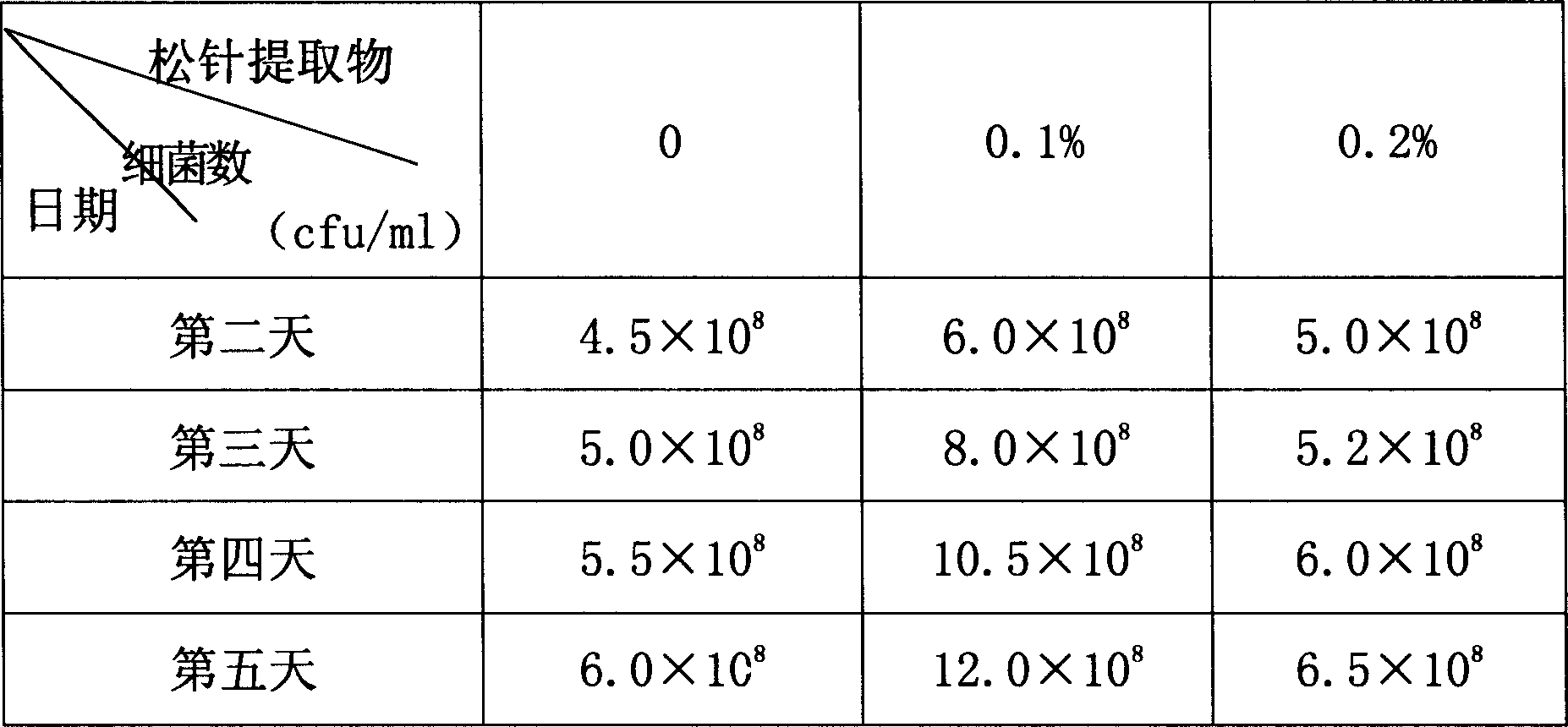Feed additive for improving animal disease-resistant ability
A feed additive and disease resistance technology, applied in animal feed, animal feed, application, etc., can solve the problems of high price and high cost, and achieve the effect of low price, low preparation cost and simple production process
- Summary
- Abstract
- Description
- Claims
- Application Information
AI Technical Summary
Problems solved by technology
Method used
Image
Examples
Embodiment 1
[0059] Compare the influence of extraction time on the solid content of the extract to determine the most optimal extraction time:
[0060] The process (extraction time described in step ③ in the preparation method) was determined by using fresh Pinus massoniana pine needles collected from Deqing Mountain, Zhejiang Province as raw materials.
[0061] Take five parts of the same number of fresh masson pine pine needles, remove other leaves, silt, and wash. First twist the pine needles into small sections of 1-5cm with a guillotine, control the ratio of pine needles to water at 1:3, smash and refine. Obtain the filtrate for the first time respectively, and set aside. Each filter residue is then extracted with 1:3 water, the extraction temperature is controlled at 80-100°C, the extraction time is 0, 30 minutes, 60 minutes, 90 minutes, 120 minutes respectively, and then filtered to obtain the second filtrate. The filtrates were combined twice and concentrated under normal pressu...
Embodiment 2
[0064] Preparation of Feed Additives Using Fresh Masson Pine Needles Collected from Deqing Mountain, Zhejiang Province as Raw Materials
[0065] Take fresh masson pine needles, remove other leaves, sediment, and wash. First, twist the pine needles into small sections of 1-5cm with a guillotine, add an appropriate amount of water in a certain proportion, break and refine. The ratio of pine needles and water can be controlled at 1:3, and the first filtrate is obtained respectively for subsequent use. Each filter residue is then extracted with 1:3 water, the extraction temperature is controlled at 80-100° C., the extraction time is 60 minutes, and then filtered to obtain the second filtrate. The two filtrates were combined and concentrated under normal pressure to obtain a tan viscous liquid. The pine needle water extract can be used as a feed additive.
[0066] Experiment 1:
[0067] Get this pine needle aqueous extract, measure the polyphenol content by the vanillin-hydroch...
Embodiment 3
[0076] Observe the effect of pine needle extract on the growth-promoting effect and disease resistance of broiler chickens:
[0077] Test with the pine needle extract prepared in Example 2, and use 1-day-old "Zhijianghuang" for broiler chickens. The tested strains were Salmonella resistant to 30ppm kanamycin and 5ppm ampicillin. The feed is full-price compound feed for chicks (see Table 1), without adding any antibiotics and anticoccidial drugs. The broiler chickens used in the test were divided into two groups: the control group (without adding pine needle extract group) and the group adding 2‰ pine needle extract, each group was 40 chickens, and the pine needle extract was mixed into the feed for feeding. 2-day-old challenge Salmonella 3 x 10 7 cfu / feather, weigh and detect Salmonella at the age of 9 days and 15 days respectively, and the detection method of Salmonella refers to the national standard (GB13091-91).
[0078] Element
Content (%)
corn ...
PUM
 Login to View More
Login to View More Abstract
Description
Claims
Application Information
 Login to View More
Login to View More - R&D
- Intellectual Property
- Life Sciences
- Materials
- Tech Scout
- Unparalleled Data Quality
- Higher Quality Content
- 60% Fewer Hallucinations
Browse by: Latest US Patents, China's latest patents, Technical Efficacy Thesaurus, Application Domain, Technology Topic, Popular Technical Reports.
© 2025 PatSnap. All rights reserved.Legal|Privacy policy|Modern Slavery Act Transparency Statement|Sitemap|About US| Contact US: help@patsnap.com

